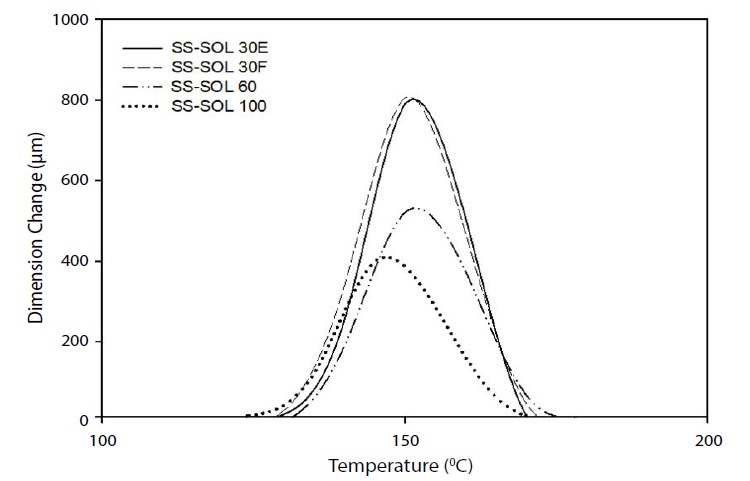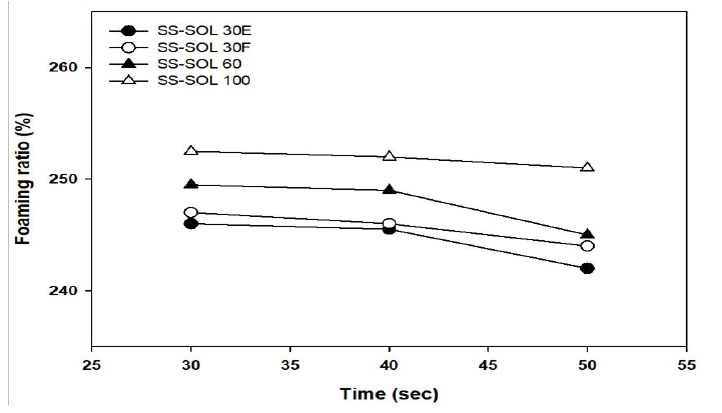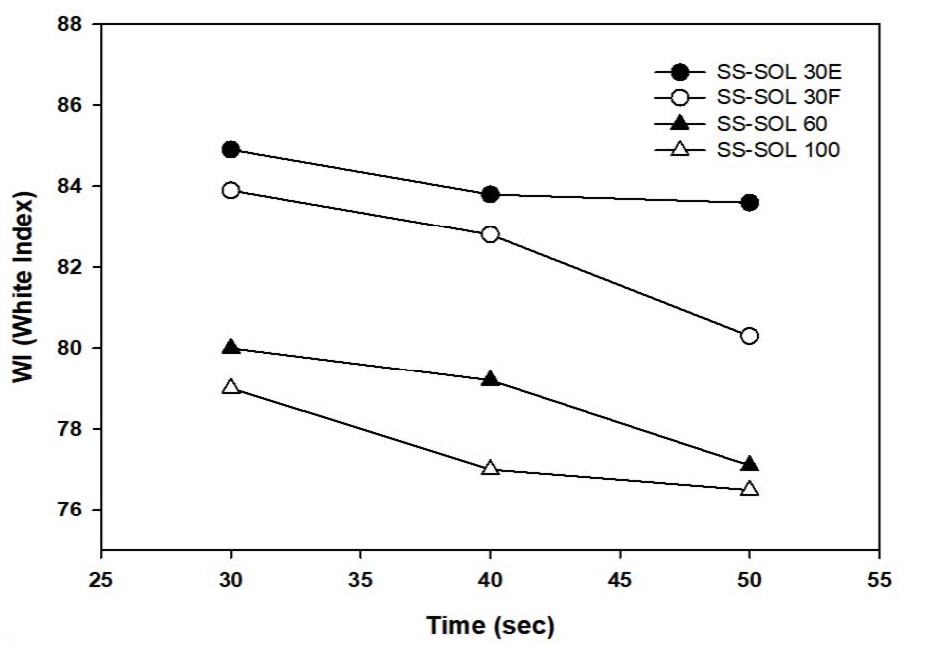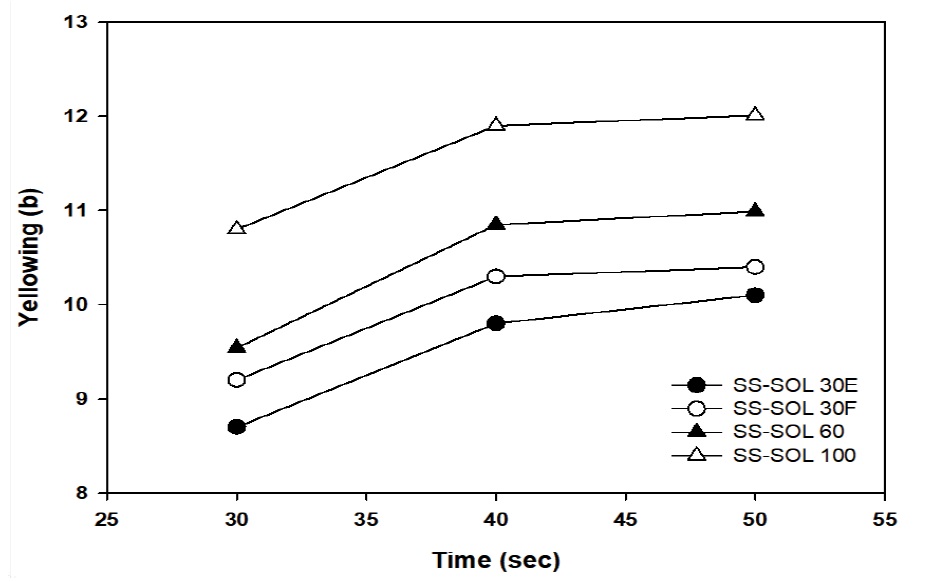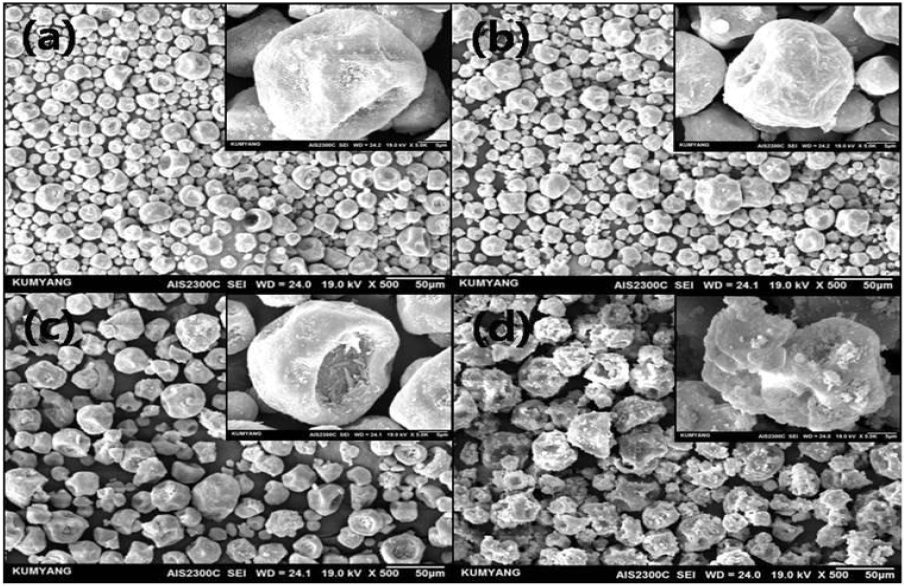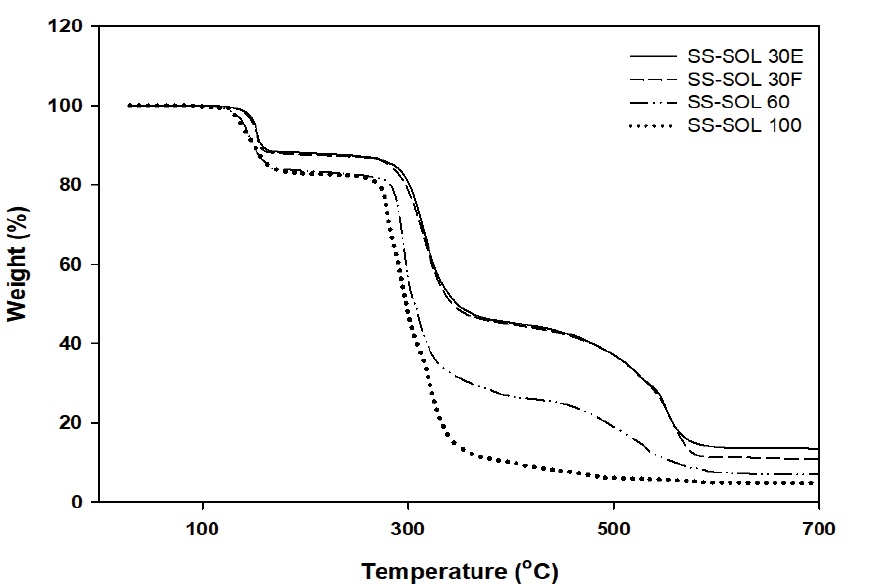Journal Name: Journal of Multidisciplinary Research and Reviews
Article Type: Research
Received date: 30 August, 2019
Accepted date: 02 September, 2019
Published date: 09 September, 2019
Citation: Myung-Jun M, Ji-Hoo K, Jae-Chun K, Jong- Chan W, Kang-Jin J, et al. (2019) The Impact of Colloidal Silica with Various Particle Sizes on Thermally Expandable Microspheres for Wallpaper Production. J Multidis Res Rev Vol: 1, Issu: 2 (01-06).
Copyright: © 2019 Myung-Jun M, et al. This is an openaccess article distributed under the terms of the Creative Commons Attribution License, which permits unrestricted use, distribution, and reproduction in any medium, provided the original author and source are credited.
Introduction
This study was conducted to improve the white index (WI) by preparing thermally expandable microspheres (TEMs) for wallpaper. The thermal properties, foam expansion ratio and WI were studied depending on the particle size of colloidal silica in the preparation of TEMs. As a result, the TEMs with small particles of colloidal silica showed the best results for whiteness and yellowing. Additionally, TGA results indicated that it was highly possible that colloidal silica with small particle sizes was physically or chemically attached to the surface of the TEMs that led to an improvement in whiteness at high temperatures.
Keywords
Colloidal silica, Particle size, Thermally expandable microspheres.
Introduction
This study was conducted to improve the white index (WI) by preparing thermally expandable microspheres (TEMs) for wallpaper. The thermal properties, foam expansion ratio and WI were studied depending on the particle size of colloidal silica in the preparation of TEMs. As a result, the TEMs with small particles of colloidal silica showed the best results for whiteness and yellowing. Additionally, TGA results indicated that it was highly possible that colloidal silica with small particle sizes was physically or chemically attached to the surface of the TEMs that led to an improvement in whiteness at high temperatures.
Keywords
Colloidal silica, Particle size, Thermally expandable microspheres.
Introduction
The polymer industry is aware of the importance of environment. At the same time, it is interested in improving energy efficiency due to recent technological advancements and environmental awareness. As the demand for energy efficiency increases sharply, various methods that involve weight lightening are proposed [1]. Weight lightening could be achieved by means of the foaming process. This process is the most commonly used method by the industry. Foaming can be largely divided into chemical foaming based on the use a chemical foaming agent and physical foaming based on physical behavior. [2,3] Conventionally, lightweighted foam is produced by forming pores in a polymer matrix, when the blend of a chemical foaming agent and polymer is heated resulting in the creation of gas bubbles. However, environmental problems came to the fore due to gases such as CO2, CO and ammonia produced during chemical foaming. Although various alternative methods of chemical foaming were proposed to overcome the environmental problems, many of these problems were not overcome due to difficulties with commercialization and high costs. Among these methods, using thermally expandable microspheres (TEMs) to obtain foam comes most closely to be used on an industrial scale. One of the advantages of foaming using TEMs is that a product can be made in various compositions, according to working conditions or a manufacturing process, without releasing harmful gas to the outside environment.
However, when compared to chemical foaming, TEMs foaming method has some problems, including low foaming pressure, application restrictions due to post-foaming discoloration, and uneven cell size. More research is required to solve these problems. In particular, the discussion about discoloration is important in the application of TEMs for wallpaper in this study. Therefore, this study prioritized finding a solution for this problem.
TEMs generally have a particle size of 10-50 μm. Their exterior is made up of thermoplastic resin, and the interior contains hydrocarbons with a low boiling point [4]. These TEMs increase in volume by more than 50 times due to the increase in pressure by the internal hydrocarbons at the temperature above the glass transition temperature of the polymeric outer shell. This is caused by the expansion due to the phase change of the encapsulated hydrocarbon. TEMs are used in various products because of this thermal expansion property. For example, they are used in the production of wallpaper, printing ink, building interior materials with applied foam, automobile interior materials, and shoe materials [5-10]. In this study, monomers with good gas barrier properties were used when they were polymerized such as acrylonitrile (AN), metha-crylonitrile (MAN) and methacrylic acid (MAA).
Discoloration became a big problem for commercial application of wallpaper. Thus, a method of solving this problem should be suggested. In order to do this, minerals serving as dispersion stabilizers in the aqueous phase were physically distributed on the surface of the droplet during the preparation of the suspension. They were chemically or physically distributed on the surface of the final TEMs depending on the size of particles distributed on the surface. These minerals can be applied to heat-resisting parts because they are absorbed uniformly on the outside.
When particles that are too large are aggregated on the TEMs’ surface, the TEMs’ size increases. In other words, a single entity is formed by multiple particles. This coagulated form causes problems such as a low foam expansion ratio and defoaming. In addition, research that focused on removing remaining monomers to prevent discoloration was conducted. This research focused on mitigating the reaction of products synthesized for the prevention of discoloration, adjusting the pH of the synthesized products to neutral and modifying the progress of the post-treatment reaction by using various initiators [11].
This study was conducted to overcome the discoloration problem and to increase the white index (WI) by other methods because this method increase wastewater by the addition of the process. We focused on testing the WI and yellowing value (b) to determine the degree of discoloration according to the particle size of colloidal silica, acting as a dispersion stabilizer. Physical properties, including magnification of TEMs, were also studied by means of thermal analysis.
Materials and Methods
The water phase containing colloidal silica (CS) and the oil phase containing a hydrocarbon (iso-pentane), as a monomer, azobisisobutyronitrile (AIBN) as an initiator and 1,4-butanediol dimethacrylate (BDDMA) as a crosslinking agent were mixed at 1,000 rpm for 10min using a homogenizer. After the suspension was prepared by spinning at a high speed, it reacted in a synthesis reactor for 16h. The suspension was washed and dried to obtain a specimen. Synthesis was carried out at 62°C and 400 rpm for 16h under the pressure of 2 kgf/cm2 with the application of nitrogen substitution for 3min in the synthesis reactor. A pitched blade turbine impeller was used in the reactor. Four types of colloidal silica were tested according to their particle sizes. In this experiment, all four types of colloidal silica (SiO2, 30±1%) were purchased from POC Inc. and used to synthesize the specimens of TEMs. They were SS-SOL 30E (15 nm), SS-SOL 30F (25 nm), SS-SOL 60 (65 nm) and SS-SOL 100 (100 nm).
Thermal expansion properties of the TEMs were measured by using a thermal expansion analyzer (TMA Q400, TA Instruments, New Castle, DE, USA) at a rate of 10°C/min from 50 to 250°C. The measured properties were the temperature at which the expansion started (Tstart), the temperature at which the maximum expansion was reached (Tmax), and the level at which the maximum expansion was reached (Dmax). The surface of synthesized microspheres was photographed by using a scanning electron microscope (SEM AIS2300C, Seron Technologies Co., Uiwang, Korea) and an optical microscope (E200LED, Nikon Instruments Inc., Melville, NY, USA). The average particle size of the synthesized microspheres was measured by using a particle size analyzer (Mastersizer 2000S, Malvern Instruments Ltd., England).
For the foaming test of the synthesized TEMs on a wallpaper, PVC (polyvinyl chloride) sol was prepared by mixing PVC (100g, LP170, LG Chem., Seoul, Korea), dioctyl phthalate (60g, Sigma-Aldrich), heavy calcium carbonate (40g, Sigma-Aldrich) and BZ810P-5 (1g, Songwon, Seoul, Korea). Dried TEMs (1g) were added into the resulting PVC sol. Then, the mixture was blended. The resulting mixture was then coated onto the wallpaper to a thickness of 120 μm. After coating, the specimens were heated at 110°C for 10s and allowed to settle on the wallpaper. After that, the foaming process was conducted at 200°C for 30, 40, and 50s under atmospheric pressure. Then, the foam expansion ratio was calculated by dividing the thickness before and after the expansion. In addition, the whiteness index (WI) and yellowing value (b) of the PVC sol foam specimen were measured with a colorimeter (Konika Minolta, CM-2500d, Konika Minolta Co., Tokyo, Japan).
Results and Discussion
The amounts of the hydrocarbon, initiator, cross-linking agent, colloidal silica (CS) and monomers, including AN, MAN and MAA are listed in table 1. The total amount was metered in 60% of the 2L test reactor volume. The used amounts of the initiator, cross-linking agent, CS, and monomers, including AN, MAN and MAA were the same and reacted under the same production conditions. Four different types of TEMs were produced and compared, based on the particle size of CS. The mean particle size of colloidal silica affected by the pH indicated that the removal rate of sapphire was marginally affected by mechanical abrasion [12]. Sumi et al. observed that all the commercially available CS dispersions show particle size of 15±5 nm in transmission electron microscopy. As shown in the TMA curve in figure 1, Dmax of TEMs increased as the particle size of CS decreased. Tstart of the TEMs made with the largest CS was measured to be lower by at least 5°C than the others.
Table 1: Formulation of thermally expandable microspheres (phm).
| Materials | SS-SOL 30E | SS-SOL 30F | SS-SOL 60 | SS-SOL 100 |
|---|---|---|---|---|
| AN | 60 | 60 | 60 | 60 |
| MAN | 15 | 15 | 15 | 15 |
| MAA | 25 | 25 | 25 | 25 |
| Hydrocarbon | 15 | 15 | 15 | 15 |
| Initiator | 1.0 | 1.0 | 1.0 | 1.0 |
| Cross-linking agent | 0.5 | 0.5 | 0.5 | 0.5 |
| Colloidal silica | 20 | 20 | 20 | 20 |
| Water | 300 | 300 | 300 | 300 |
Figure 1: TMA Curve for the TEMs made of various types of colloidal silica.
As compared Dmax and Tstart based on the particle size of CS, the difference in this result could occur because the internal pressure of the hydrocarbons inside the TEMs failed to overcome the pressure of the wall composed of the outer thermoplastic resin. Table 2 shows the TMA results for each sample and the particle size and span of the synthesized TEMs. The lower thermal degradation and lesser char yield observed for pure polydimethylsiloxane (PDMS) in an inert atmosphere is usually attributed to depolymerization of PDMS and formation of volatile cyclic oligomers [13]. When the TEMs were prepared by using CS, small TEMs could be produced by using small particle sizes. The obtained particle size distribution had a relatively more uniform value because the span indicating the uniform distribution value was lower. To apply TEMs to wallpaper, 50g of PVC sol and 1g of the TEMs were blended and then heated at 110°C for 10s in order to fix the blended PVC sol on wallpaper. After that, it was foamed at 200°C under atmospheric pressure for 30, 40, and 50 s, consequently.
Table 2: Effects of colloidal silica on the properties of the TEMs.
| Codes | SS-SOL 30E | SS-SOL 30F | SS-SOL 60 | SS-SOL 100 |
|---|---|---|---|---|
| Tstart (°C) | 128.5 | 128.9 | 131.1 | 123.4 |
| Tmax (°C) | 149.3 | 148.8 | 151.3 | 146.7 |
| Dmax (μm) | 805.2 | 809.3 | 547.6 | 412.5 |
| Particle size (μm) | 21.33 | 25.21 | 25.59 | 61.70 |
| Span | 1.703 | 1.726 | 1.908 | 2.257 |
The foam expansion ratio was expressed as a percentage by dividing the thickness before and after foaming. The expansion ratio of SS-SOL 100 with the largest particle size was the highest, and that of SS-SOL 30E with the smallest particle size was the lowest among the specimens. The expansion ratios of specimens decreased as the time of their exposure to heat increased. It appears that when exposed to a temperature higher than Tmax, the TEMs’ outside resin was shrunken by softening. When the TEMs’ foam expansion ratio with the largest CS was compared to that with the smallest CS, the large CS were favorable but the difference was within 8%. The results were inversely related to the comparison of the difference in foaming through Dmax in TMA. The critical volume fraction for colloidal crystallization depends on the extent of modification and molecular weight of the grafted polymer [14]. In case of foaming on wallpaper, it is foamed under atmospheric pressure, but in the case of TMA, the probe pressed the pen containing specimen with a force of 0.01N. The pressure difference between the two cases seems to bring different results (Figure 2).
Figure 2: Effects of various types of colloidal silica on the foam expansion ratio of the TEMs.
In the application of TEMs for wallpaper on an industrial scale, discoloration and whiteness are the most important after foaming (although the difference in the foam expansion ratio is important). Therefore, the samples foamed at 200°C for 30, 40, and 50 s were compared by their white index (WI) and yellowing value (b). The higher the WI, the closer to white, and the lower the yellowing value (b), the less yellowing progressed. As a result of measuring the WI with the colorimeter, the whiteness of the TEMs’ sample with the smallest CS particle sizes (15 nm) was the highest. On the other hand, the whiteness of the TEMs’ sample with the largest CS particle sizes (100 nm) was the lowest. In addition to the difference in WI and yellowing value (b) when measured with a colorimeter, there was a significant difference in discoloration that could be confirmed with the naked eye (Figure 3).
Figure 3: Effects of various types of colloidal silica on the WI of the TEMs.
The yellowing value (b) of the TEMs’ sample with the smallest CS particle size was the lowest. Even though exposure to high temperatures caused yellowing, smaller particle size resulted in lower yellowing value (b) (Figure 4).
Figure 4: Effects of various types of colloidal silica on the yellowing value (b) of the TEMs.
The surface analysis of the TEMs was conducted by using SEM. In Figure 5 (a), there was almost no aggregated particles on the surface. However, somewhat roughly cohered parts on the surface show in Figure 5 (d). The surface shapes shown in Figure 5 (a) and (b) appeared when the TEMs were observed by a general SEM. It was confirmed that the surface shape as shown in Figure 5 (d) was due to the partial adsorption of silica with large particle sizes. Therefore, it seems that the problem of discoloration occurred at 200°C, which is a relatively high temperature. TGA analysis was performed to confirm this. Most organic materials decompose at 600°C. We assumed that silica can withstand more than that temperature. The test was performed by heating it to 700°C, starting from the room temperature and at the rate of 20°C/min.
Figure 5: SEM images of the tems with various types of colloidal silica, including (a) SS-SOL 30E, (b) SS-SOL 30F, (c) SS-SOL 60, and (d) SS-SOL 100.
In the case of the TEMs made with CS with the smallest particle size, 14% (w/w) of the inorganic substance remained. The extent of interactions in the filler–filler and the filler–polymer was found to vary with the surface modification and the dispersion medium, with which CS was dispersed into the PDMS matrix [13]. The larger the CS particles, the lower the inorganic content was. This is important because the adsorbed amount of silica physically or chemically bonded to the surface of the TEMs decreased as the particle size of CS increased. Yoshinaga et al. suggested that colloidal crystallization of the polymer-modified silica in organic solvent is affected by complicated factors coming from intrinsic properties of the original silica surface and modified polymer chains.
In the case of the TEMs made with CS with the smallest particle size, 14% (w/w) of the inorganic substance remained. The extent of interactions in the filler–filler and the filler–polymer was found to vary with the surface modification and the dispersion medium, with which CS was dispersed into the PDMS matrix [13]. The larger the CS particles, the lower the inorganic content was. This is important because the adsorbed amount of silica physically or chemically bonded to the surface of the TEMs decreased as the particle size of CS increased. Yoshinaga et al. suggested that colloidal crystallization of the polymer-modified silica in organic solvent is affected by complicated factors coming from intrinsic properties of the original silica surface and modified polymer chains (Figure 6).
Figure 6: TGA Curve of the TEMs with various types of colloidal silica.
Conclusion
The main purpose of this study was to investigate how TEMs could be applied for wallpaper. In order to overcome discoloration and improve whiteness, physical and chemical adsorption with more content than conventional colloidal silica content (%, w/w) was tried to be induced on the surface of the microsphere. For this purpose, the thermal properties such as discoloration, whiteness and the foam expansion ratio were studied depending on colloidal silica’s particle sizes. In particular, when the TEMs with small particles of colloidal silica were produced, the agglomerated TEMs’ shape was not shown on their surface. The reason could be that the silica was uniformly adsorbed on the surface. Also, TGA analysis showed that the TEMs with small particles of colloidal silica contained a large amount of inorganic substance, which supports this argument. As a result, when colloidal silica with small particle sizes was used in the monomers and synthetic environments in this study, there was not a significant difference in the foam expansion ratio. However, it contributed greatly to yellowing resistance and improvement whiteness. It appears to be suitable to apply TEMs for the production of wallpaper.
Acknowledgement
This research was supported by the World Class 300 Project R&D Support Project (S2433278) of Korea Ministry of SMEs and Startups.
There are no references
